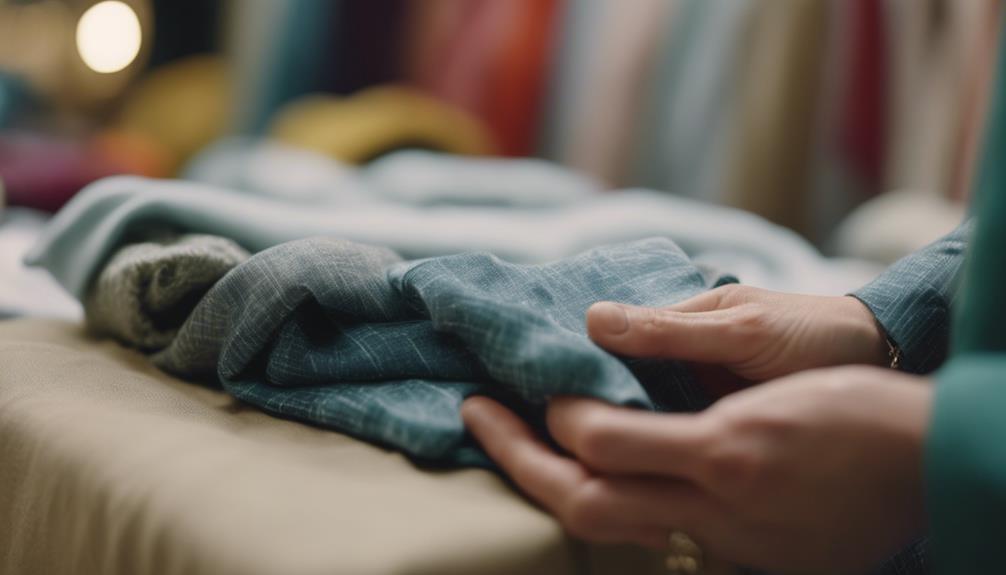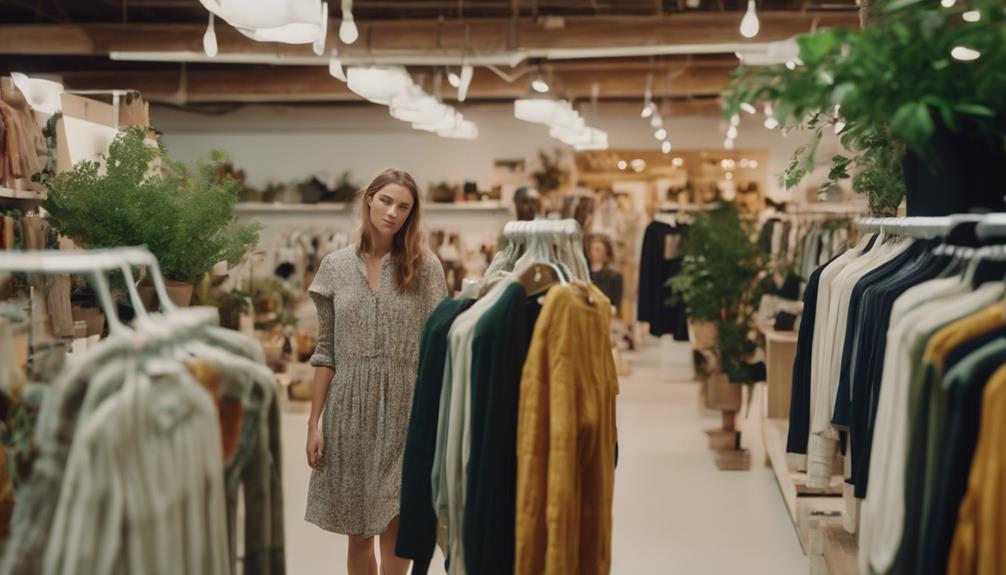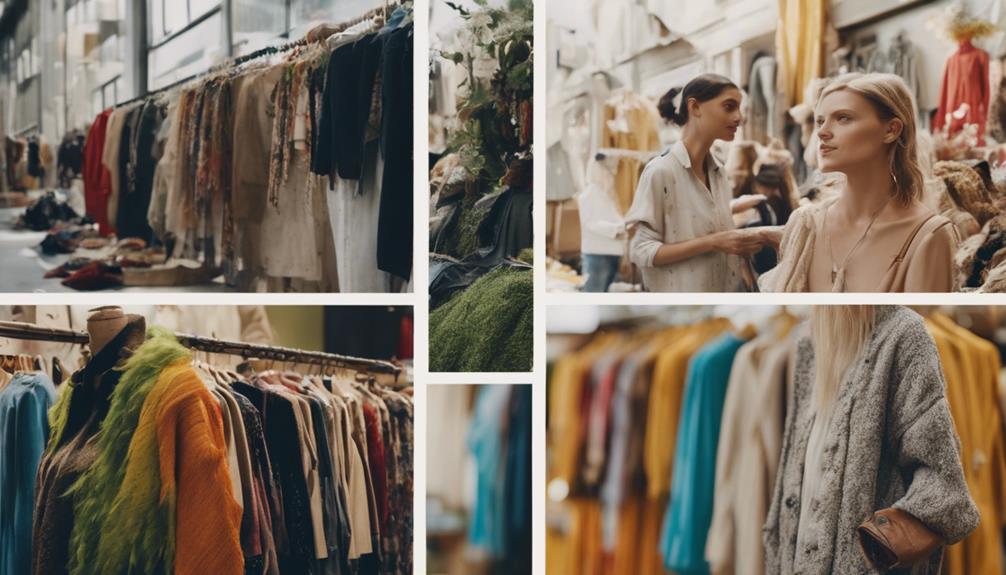You may be surprised to discover that the majority of customers are willing to pay a higher price for sustainable fashion. In fact, 66% of shoppers prefer sustainable brands, with an impressive 73% of millennials willing to shell out extra money for eco-friendly options. Even Generation X demonstrates a strong commitment, with 90% considering sustainability important when making purchases. However, many retailers underestimate this willingness. Around 30% of consumers list environmental improvement as a significant motivating factor in their purchasing decisions. As you delve deeper, you will see how this trend is influencing the future of fashion and consumer behavior.
Key Takeaways
- 73% of millennials and 90% of Gen X consumers are willing to pay more for sustainable fashion items.
- Two-thirds of global consumers express a willingness to pay a premium for sustainable choices.
- 58% of consumers across demographics prioritize sustainability when making purchases.
- 30% of shoppers cite environmental improvement as a key motivation for buying sustainable products.
The Appeal of Sustainable Fashion
As more consumers recognize the environmental impact of their choices, the appeal of sustainable fashion continues to grow, making eco-friendly brands increasingly desirable.
You're likely aware that a significant 66% of global consumers prefer sustainable brands, highlighting a shift in priorities towards environmentally-conscious choices. This trend isn't just limited to one age group; millennials and Gen X are particularly drawn to sustainable products.
In fact, 73% of millennials are willing to pay more for items that align with their values, while 90% of Gen X consumers have shown a notable increase in their willingness to spend extra on sustainable goods. These statistics reflect a broader cultural shift towards sustainability, where you might find yourself gravitating towards brands that prioritize eco-friendly practices.
Additionally, the rising popularity of second-hand and upcycled goods offers a practical alternative for those who want sustainable fashion without breaking the bank.
Consumer Willingness to Pay More

You might be surprised to see how different generations approach spending on sustainable fashion.
While younger consumers are keen to invest more for eco-friendly options, many retailers seem out of touch with this growing demand.
Let's explore these generational spending trends, the environmental motivations behind them, and the misalignment issues retailers face.
Generational Spending Trends
Generational spending trends reveal a growing willingness among consumers to pay more for sustainable fashion, with significant shifts seen particularly in Gen X and millennials. You might be surprised to learn that 90% of Gen X consumers are now ready to spend extra for sustainable products, a dramatic leap from just 34% two years ago. Millennials aren't far behind, with 73% prioritizing sustainability in their purchasing decisions.
Here's a quick glance at how different generations view sustainable fashion:
| Generation | Percentage Willing to Pay More | Focus on Sustainable Brands |
|---|---|---|
| Gen Z | Expected 27% of global income by 2030 | Strongly prefer eco-friendly options |
| Millennials | 73% | Favor sustainable brands |
| Gen X | 90% | Prioritize ethical fashion |
| Global Consumers | 66% | Indicate a trend towards sustainability |
These statistics highlight a broad trend towards sustainable fashion across generations. However, it's worth noting that two-thirds of retailers still underestimate consumers' willingness to pay for sustainable products, revealing a gap between consumer demand and retail perceptions.
Environmental Motivations
Driven by a strong commitment to environmental improvement, many consumers are increasingly willing to pay more for sustainable fashion options. A significant 73% of millennials express their readiness to invest extra in sustainable products, highlighting a shift towards eco-friendly choices. This trend isn't limited to one generation; 58% of consumers across all demographics said they'd pay a premium for sustainable options.
Environmental motivations play a vital role in these purchasing decisions, with 30% of consumers prioritizing sustainability as their primary reason for buying. Even more compelling, 90% of Gen X consumers are willing to pay more for sustainable products, a remarkable rise from just 34% two years ago.
Furthermore, over half of consumers actively consider a brand's environmental impact before making a purchase, which underscores the growing importance of sustainability in consumer behavior. It's clear that an increasing number of you aren't just looking for stylish options but also weighing the environmental implications of your choices.
This shift towards sustainable fashion reflects a collective desire to contribute positively to the planet while maintaining a stylish wardrobe.
Retailer Misalignment Issues
Retailers often misjudge consumer willingness to invest in sustainable products, underestimating the strong demand for eco-friendly options. Surprisingly, two-thirds of consumers are willing to pay more for sustainable choices, yet many retail executives believe that consumers prioritize brand names over sustainability. This misconception creates a disconnect; while 73% of millennials express a willingness to pay extra for sustainable options, half of retailers still think this factor isn't essential for consumers.
Moreover, 60% of consumers feel that retailers are transparent about their sustainability efforts, but retail executives assume consumers perceive a lack of transparency. This gap in perception highlights a vital misalignment. By ignoring the rising consumer interest in sustainability, retailers risk alienating a significant segment of their customer base.
To bridge this gap, retailers must prioritize transparency and genuinely listen to consumer feedback. Acknowledging consumers' readiness to pay more for sustainable products can lead to enhanced offerings and build trust. If retailers align their strategies with consumer values, they can foster loyalty and support from a growing audience keen on sustainable fashion.
Retailers' Perspective on Sustainability

You might be surprised to learn that many retailers miss the mark when it comes to understanding consumer expectations around sustainability.
This misalignment can cost them a competitive edge, especially when transparency in their practices is increasingly demanded by shoppers.
Misalignment With Consumer Expectations
A significant gap exists between what consumers expect regarding sustainability and how retailers perceive those expectations. While two-thirds of consumers are willing to pay more for sustainable products, many retail executives believe that consumers prioritize brand names over sustainability. This misalignment can lead to missed opportunities for both parties.
Consider these points:
- Half of consumers evaluate a brand's environmental impact before purchasing, yet half of retailers think sustainability isn't a key factor.
- 60% of consumers feel retailers are transparent about their sustainability efforts, while 100% of retail executives think consumers lack this perception.
- Two-thirds of retailers underestimate the willingness of consumers to pay a premium for sustainable fashion.
This disconnect between consumer expectations and retailer assumptions about sustainability suggests that retailers may need to reassess their strategies.
Sustainability as Competitive Advantage
Leveraging sustainability can transform a brand into a market leader, capturing the growing consumer base enthusiastic for eco-friendly options. You might be surprised to learn that two-thirds of retailers underestimate consumer willingness to pay more for sustainable products. In fact, 66% of global consumers prefer sustainable brands, revealing a significant opportunity for those willing to embrace ethical fashion.
Millennials, in particular, are driving this change; 73% indicated they'd pay extra for sustainable goods. However, many retail executives still prioritize brand name over sustainability, even as only 56% of consumers share that view. This disconnect highlights an opportunity for brands to align with consumer demand for eco-friendly options.
Adopting sustainable practices not only resonates with customers but also offers a competitive advantage. Companies that embrace sustainability report a 10-20% increase in sales, proving that it pays to go green.
Transparency in Practices Needed
Understanding the gap between consumer expectations and retailer perceptions is essential for fostering transparency in sustainability practices. While two-thirds of consumers express a willingness to pay more for sustainable products, many retail executives underestimate this priority. This disconnect indicates a significant need for better communication regarding sustainability efforts between you and your customers.
To bridge this gap, consider the following points:
- Consumers value transparency: 60% believe that retailers are open about their sustainability practices.
- Environmental impact matters: Half of consumers evaluate a brand's environmental impact before purchasing.
- Feedback is important: Listening to customer input can enhance your sustainability initiatives.
Motivations Behind Sustainable Purchases

When choosing sustainable fashion, many consumers are driven primarily by the desire to improve the environment. In fact, about 30% of shoppers cite environmental improvement as their main motivation for opting for eco-friendly products. You might be one of the approximately 50% of consumers who consider a brand's environmental impact before making a purchase, showcasing a strong commitment to sustainability.
Moreover, people are increasingly aware of their buying habits and the broader implications they hold. Approximately 23% of consumers are motivated by the desire to reduce production waste, while 22% aim to decrease their carbon footprint through their choices in sustainable fashion. This growing concern for climate change reflects a shift in priorities for many shoppers.
Additionally, companies that adopt sustainable practices often see a boost in consumer loyalty, which can translate into a 10-20% increase in sales. By supporting brands that prioritize sustainability, you contribute to a larger movement toward environmental responsibility. Ultimately, your choices not only impact the planet but also encourage businesses to maintain eco-friendly practices in order to retain loyal customers like you.
Challenges in Sustainable Fashion

Steering through the challenges in sustainable fashion can be intimidating, especially with the disconnect between consumer willingness to pay and the perception of sustainable products.
While many consumers express interest in sustainable fashion, only 1-7% are ready to pay a premium. This creates a significant gap between awareness and actual purchasing behavior.
The fast fashion culture complicates things further. Consumers are often lured by low-cost, trendy items, prioritizing immediate gratification over long-term environmental impact.
Misconceptions about sustainable fashion add to the hurdles, as many people believe these options are only available in high-end markets.
Here are some key challenges:
- Limited consumer engagement: Many consumers lack awareness of sustainable options.
- Fast fashion dominance: The allure of cheap, trendy clothes overshadows sustainability.
- Cost perceptions: Misunderstandings about the affordability of sustainable products persist.
Addressing these challenges is vital for bridging the gap between consumer interest and sustainable purchasing, fostering a more environmentally conscious fashion industry.
Innovations Driving Change

Despite the challenges in sustainable fashion, innovative solutions are emerging that promise to reshape the industry and align better with consumer values.
One of the most exciting innovations is the development of biodegradable materials, offering eco-friendly alternatives that greatly reduce environmental impact. You'll find that plant-based alternatives, like vegan leather, aren't only appealing to your conscience regarding animal welfare but also help lower carbon emissions.
Smart packaging technologies are also making waves, designed to minimize waste and enhance sustainability in fashion retail, which is something you might appreciate as a conscious consumer. Additionally, advancements in water conservation technologies during production processes are addressing the fashion industry's major contribution to water pollution—an issue many consumers care deeply about.
As brands increasingly adopt renewable energy sources in their manufacturing processes, they're actively working to lower their carbon footprints. This shift not only meets your expectations for sustainability but also reflects a growing commitment within the industry to combat environmental challenges.
These innovations are paving the way for a more sustainable future in fashion, making it easier for you to make responsible choices.
Future Trends in Consumer Behavior

As sustainability becomes a top priority for consumers, upcoming trends will likely reflect a stronger demand for eco-friendly fashion choices. By 2030, it's projected that a staggering 80% of you will prioritize sustainability in your purchasing decisions. This shift isn't just a trend but a fundamental change in how you view fashion.
Here are some key trends to watch for:
- Increased willingness to pay: A significant number of you, especially millennials and Gen X, are expressing a willingness to pay more for sustainable products.
- Rise of second-hand and upcycled goods: You're increasingly interested in circular fashion models, showcasing a preference for items that promote sustainability.
- Disconnect with retailers: Many brands underestimate your willingness to spend extra on sustainable items, which could lead to missed opportunities in the market.
In this evolving landscape, your commitment to sustainability will shape the future of fashion, pushing brands to align with your desires for eco-friendly choices.
Building Trust in Sustainable Brands

Building trust in sustainable brands hinges on clear communication and transparency about their eco-friendly practices. As a consumer, you want to know that the brands you support genuinely align with your values.
With two-thirds of consumers willing to pay more for sustainable products, it's essential for brands to clearly outline their sustainability efforts. Interestingly, 60% of consumers believe retailers are transparent about their commitments, but there's still room for improvement.
Brands that effectively communicate their practices not only enhance consumer understanding but also build lasting trust. When you see a brand openly sharing details about their sourcing, production, and environmental impact, it reassures you that they're dedicated to sustainability.
Moreover, the financial benefits are evident: brands adopting sustainable practices report a 10-20% increase in sales, reflecting the growing demand for ethically made products. This trend is particularly strong among Gen X consumers, with 90% expressing a willingness to spend extra.
Frequently Asked Questions
Are People Willing to Pay More for Sustainable Fashion?
Did you know 73% of millennials are ready to spend more on sustainable fashion? People increasingly value eco-friendly choices, showing a significant shift in purchasing habits towards brands that prioritize sustainability and ethical practices.
Do Consumers Actually Pay More for Sustainability?
You might think many consumers pay more for sustainability, but the reality shows only a fraction actively choose sustainable brands despite their expressed willingness. This gap highlights a significant disconnect in consumer behavior and purchasing decisions.
Do Consumers Want More Sustainable Fashion?
Did you know that 66% of global consumers prefer sustainable brands? This strong preference shows you're not alone in wanting more eco-friendly options in fashion, reflecting a growing awareness of the impact of your choices.
Are Consumers Willing to Pay More for Sustainable Products Nielsen?
You're part of a growing trend where consumers increasingly value sustainability. Recent data shows that a significant number of you are willing to spend more on eco-friendly products, reflecting a shift towards responsible purchasing habits.
Are the Shocking Findings About Consumer Preferences for Sustainable Fashion True?
The shocking findings about consumer preferences for sustainable fashion have been confirmed by multiple surveys and studies. More and more consumers prefer sustainable fashion over fast fashion, as they become increasingly aware of the environmental and social impact of their purchasing choices. This trend is reshaping the fashion industry.
Conclusion
So, are you ready to embrace sustainable fashion?
The truth is, many consumers are willing to pay a premium for it, but the journey doesn't stop there.
As you navigate this evolving landscape, keep an eye on innovations and trends that could reshape your shopping habits.
Will you join the movement and support brands that prioritize the planet?
The choice is yours, and it could change the future of fashion—one conscious purchase at a time.









